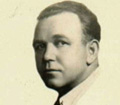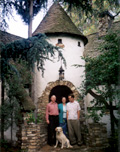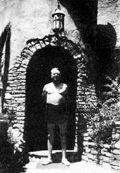|
|
William S. Hart & Charley Mack
Newhall, California

Click image to enlarge Actor and neighbor William S. Hart (right) with vaudevillian Charley Mack outside the master bedroom of Mack's main house (of three) on 8th Street in Newhall in 1933. (We know it's 1933 because another photo in this series is dated.) About Charley Mack
About Charles E. "Charley" Mack. Charles Mack was born Charles E. Selders in White Cloud, Kansas, on Nov. 22, 1887, but he grew up in Tacoma, Washington. He was half of the "Two Black Crows" blackface vaudeville team with George Moran, and he built a compound of three houses in Newhall where he lived in the 1920s and '30s. By his own account, Mack played professional baseball as a young man in Olympia, Wash., where he was known as "the man in the iron mask" (he was a catcher). "The street car company owned the ball club," he writes, "and in my spare time I was a conductor on the cars. This so electrified me that I got a job as an electrician in a Tacoma theatre, my first experience in show business." "Sometimes the actors ran out of juice," he continues, "and I supplied it to them in the shape of new acts. After a while I thought that as long as the actors liked my stuff I might as well write an act for myself and be an actor. So I scraped some black off the kitchen stove and went on the stage. I didn't have nerve enough to do it whiteface." Mack — who signed his name "Charley Mack" — hired John Swor as his first partner and eventually hired Moran to replace him when Swor left. "Since then I have called my act Moran & Mack — The Two Black Crows. Vaudeville audiences both here and in England seemed to like it," he writes. Among their notable appearances were with W.C. Fields in vaudeville, and in the Ziegfeld Follies of 1920 and Earl Carroll's Vanities on Broadway. "Phonograph records, based on my acts, made noises in about 7,000,000 homes," he writes. "I also got into a lot more million living rooms through the radio." "The Two Black Crows" became a weekly radio show in 1928 and centered around corny (and usually non-racial) jokes and gags. Like their 1929 Paramount comedy of the same name, one of their catch phrases was "Why bring that up?" It was Mack's retort when Moran would remind him of something better left forgotten. Another was, "Who wants a worm, anyhow?" — Mack's retort when Moran would tell a parable ending in the admontion, "The early bird catches the worm." Mack also wrote a novel in 1928, "The Two Black Crows in the A.E.F.," which Paramount turned into the 1930 Mack & Moran picture, "Anybody's War." Meanwhile, Newhall was close enough to Hollywood yet remote enough to serve as a getaway. Mack built himself a unique gingerbread home in the French Norman style on 8th Street, west of Market Street, around 1924, and added two smaller cottages at the end (top) of 8th Street. Collectively the compound was known as Crowland. Mack entertained the likes of William S. Hart, Noah Beery, his partner Moran, and many other celebrities. Moran and Mack's entry into movies at the height of their popularity caused a rupture. Moran reportedly sued Mack in a salary dispute over 1929's "Why Bring That Up?"; the court ruled that Mack owned the act and could set the salaries. Moran left and Mack replaced him with John Swor's brother, Bert Swor, who became the new "Moran." George Moran sued in January 1930 to block the new duo from using "his" name, but court documents showed that Moran wasn't George Moran's real name; it was George Searcy. The turmoil in the partnership was short-lived. Charles Mack and George Moran appeared together in at least four more films from 1930 to 1933, and Moran was in the car when Mack died in a crash in Mesa, Ariz., on Jan. 11, 1934. Also in the car was film pioneer Mack Sennett, who had attempted a comeback in 1932 when he directed a Mack and Moran picture, "Hypnotized." The group, which included Mack's wife Myrtle and daughter Mary Jane, was reportedly en route back from signing a contract with Columbia in New York. The others weren't seriously injured. Following Mack's death, W.C. Fields lived in Mack's main 8th Street house for a short time (circa 1935-36). Moran tried to revive the Two Black Crows with different partners, without success; he did appear in two later W.C. Fields films: "The Bank Dick" and "My Little Chickadee" (both 1940); "Chickadee" is said to have filmed in a house at Monogram Ranch, later called Melody Ranch, in Placerita Canyon. That same year, Monogram exec Ray Johnston purchased Mack's main house on 8th Street. He sold it in 1943. "Our" Charles Mack should not be confused with 1920s actor Charles Emmett Mack, who died in a 1927 car crash. Further reading: 8th Street Home Popular with Vaudeville Greats. Further reading: Architect Sues Mack for False Claims About 8th Street House Designs, 1931.
William S. Hart
Biography by Friends of Hart Park
When William S. Hart began his film career in 1914, he initiated a fresh approach to Westerns that continues to influence the genre today. Although Western motion pictures were already very popular, for the most part they were exercises in mediocrity, filled with "impossibilities or libels on the West," according to Hart in his 1929 autobiography, My Life East and West. But in the course of appearing in or producing more than 60 movies over an eleven-year span, William S. Hart created a film style that revealed a more authentic vision of the Old West. At the same time, he made a major contribution to film history by developing and embodying the prototype of the frontier hero. Fame, artistic recognition, and wealth were Hart's rewards.
A Childhood in the West
William Surrey Hart was born in Newburgh, New York, probably in 1864. During his boyhood, his family traveled extensively in the Midwest as his father searched unsuccessfully for the ideal site to build a gristmill and make a permanent home for his family. Young Bill was raised in a pioneer atmosphere; he had contact with Indians, ranchers, and cowboys and learned Indian sign language and a little of the Sioux language from his playmates. He gained a respect for Indians and their cultures that he never lost.
Hart's First Career
The Hart family returned to New York while Bill was in his early teens, and it was there that he developed an interest in the stage. By 1900 he had appeared in productions from New York to San Francisco to Montreal. He received critical acclaim for his own production of The Man in the Iron Mask and his creation of the role of Messala in Ben Hur. Hart's first Western role was also in a stage production: in 1905, he was cast as "Cash" Hawkins in The Squaw Man. His subsequent stage roles were primarily Western and included the lead in an enormously successful production of The Virginian.
Two Gun Bill
While touring with the company of The Trail of the Lonesome Pine in 1914, Hart decided to move to California to make Western films. In his autobiography, he wrote, "I was an actor and I know the West. ... I had to bend every endeavor to get a chance to make Western motion pictures." Hart obtained parts in several Westerns and collaborated in writing screenplays, and his film career was launched. As a filmmaker, Hart drew on his childhood experiences, insisting on using realistic costumes, locales, and situation. The public loved "Two Gun Bill" and his movies, and he obliged the fans with one success after another. He became one of Hollywood's top actors and most successful directors.
La Loma del los Vientos
Some of Hart's Westerns were shot on and around a ranch in Newhall, California. In 1921[1] he purchased the property from Babcock Smith. After completing Tumbleweeds (1925), his final film and one of his finest, Hart commissioned Los Angeles architect Arthur Kelly to design a magnifient Spanish colonial-style mansion, which Hart christened La Loma de los Vientos (Hill of the Winds) and occupied in 1927. Hart filled his home with treasure reflecting his interest in the West, including Navajo textiles, Indian costumes, guns and weapons, and Western paintings and sculptures. In his retirement, he became active in the operation of his ranch and deeply involved in Santa Clarita Valley community affairs. He wrote more than a dozen novels and short stories as well as his fascinating autobiography, My Life East and West. Hart's reputation as a Western figure put him in contact with other prominent personalities of the day. Western enthusiasts, such as Will Rogers and Wyatt Earp, and important artists, including Charles M. Russell, C. C. Crisadoro, and James Montgomery Flagg, visited the ranch or corresponded with Hart.
The Hart Legacy
True to the spirit of Western heroes he had portrayed on screen, Hart was humbly grateful to the fans who had supported his film career. "While I was making pictures, the people gave me their nickels, dimes, and quarters. When I am gone, I want them to have my home." When he died in 1946, he left the bulk of his estate to the County of Los Angeles, stipulating that his house and the ranch property were to be used as a museum and public park. Today, the Parks and Recreation Department of Los Angeles County operates and maintains William S. Hart Park, which includes hiking and nature trails, a large picnic area, a campground, an exhibit of farm machinery, an assortment of live animals including a herd of bison, and approximately 110 acres set aside as a wilderness area. The Natural History Museum of Los Angles County is responsible for the interpretation of the historical portion of Hart's bequest, which includes his home and its contents and several other buildings. The Friends of Hart Park and Museum, an active group of local citizens, provides volunteer support services. La Loma de los Vientos stands today not only as a tribute to William S. Hart but as a valuable and edifying museum. Hart's personal effects and movie paraphernalia are displayed in his home along with Indian artifacts and Western American art that he amassed. These materials form a major resource for understanding the American West as it was perceived in the early part of the century. 1. Note: Original piece from Friends of Hart Park said 1925. Hart biography ©Friends of Hart Park • Used by permission.
LW2319: 9600 dpi jpeg from color photocopy of original BW print | Collection of Norman and Cynthia Harris |
Charley Mack
Newhall House Story
Letter Authorizing Construction 7-16-1929
Mack's 1928 Novel
"Why Bring That Up?" 1929 (Mult.)
"Anybody's War" 1930
Moran & Mack Lawsuit 1930
Paramount Ad 1930
In Character 1931
Architect Sues 1931
Sues Ex-Secretary for Embezzlement 1932
Wm. S. Hart & Charley Mack in Newhall 1933
Wallace Beery, Hart, Moran, Mack in Newhall 1933
With Wm. S. Hart in Newhall 1933
With Moran ~1933
W.C. Fields at Mack House ~1935
Main House
22931 8th St.
Other Mack Hous
23021 8th St.
Other Mack House
23031 8th St.
|
The site owner makes no assertions as to ownership of any original copyrights to digitized images. However, these images are intended for Personal or Research use only. Any other kind of use, including but not limited to commercial or scholarly publication in any medium or format, public exhibition, or use online or in a web site, may be subject to additional restrictions including but not limited to the copyrights held by parties other than the site owner. USERS ARE SOLELY RESPONSIBLE for determining the existence of such rights and for obtaining any permissions and/or paying associated fees necessary for the proposed use.


















